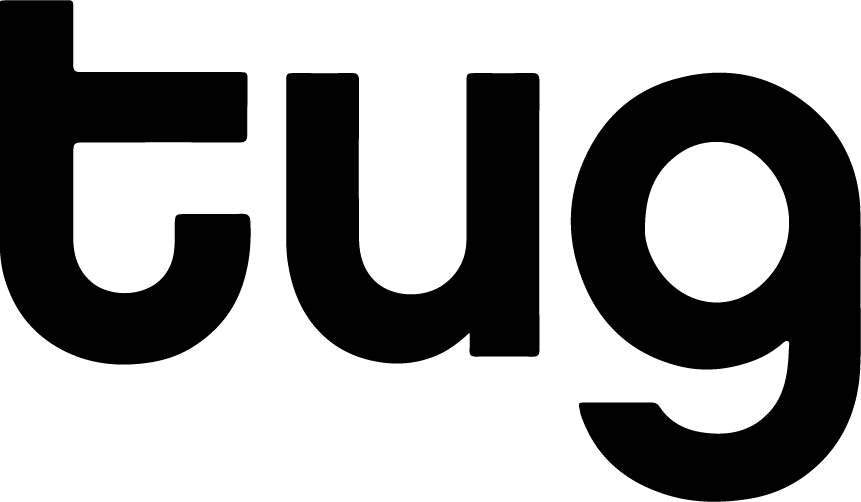TikTok has become a global phenomenon with a total of 800 million users worldwide. The marketing potential is huge and the reason for this is because TikTok’s short-form video model is loved by young audiences who prefer bite-sized content. In addition to this, what other platform offers such sophisticated editing tools? The experience is totally immersive and allows the audience to become the creators. We also cannot downplay TikTok’s ability to captivate audiences for long periods. Since COVID-19, there has been an 18% increase in time spent on the platform in the UK and the US (Social Chain TikTok for Brands webinar June 18th, 2020.)
So, if you are wondering; should my brand be on TikTok? The most likely answer is yes. Providing you are willing to do your research and make sure your brand’s identity fits with the platform trends. Below are ten top tips for marketing on TikTok.
- Capitalise on your niche
To be successful on TikTok you need to understand what content is being created by your fans and your competitors. A tip is to engage with relevant content within your niche. For example, an environmental brand might like and comment on environmental content. This alerts the TikTok algorithm to serve more similar content so that you can familiarise yourself with audience interests within your niche. Another tip is to think outside the box, look at trends that cross other niches e.g. fashion, food and travel to see how brands have become involved in challenges and aligned their interests with these challenges. Check out how Fenty Beauty jumped on the wipe the mirror challenge.
- People first, product second
The most successful brands on TikTok recognise that it is a people-first platform. The recommended approach is always people first, product second. The content should always use people to tell the story.
- The importance of sound
When promoting your product or service, make sure you identify the right creators for your brand. TikTok is oriented on sound – Gym Shark have made influencers the voice of their content, helping to create a brand identity on TikTok. Every video should include music or sound to drive engagement.
- Speed is essential
If a challenge emerges that fits your brand’s niche, it is important to react and create content quickly. Internal barriers that prevent content being created, approved and published quickly will likely affect your brand’s opportunity to jump on relevant trends and test the waters.
- Low barrier to entry challenges
If you are thinking about creating a branded challenge, remember low barrier to entry is essential. Make sure that your challenge is clear and easy to understand – the more relevant your challenge, the more likely people are to take part. For example, take the wipe the mirror challenge which emerged during COVID-19 and allowed people to dress up as if they were going on a night out. This was hugely successful because it allowed people to dress up in a time where there was nothing to dress up for. Relevancy is key.
- Create content for TikTok
Understanding TikTok’s editing tools are key for creating organic TikTok content. Familiarise yourself with what the tools allow you to do by checking out TikTok editing tutorials on YouTube. Here is a good example.
This is especially important if you are considering repurposing existing content as it must be native to the page. Overlaying stickers and text boxes will ensure that your video content is not jarring in the newsfeed.
- Don’t make ads, make TikToks
Do not think simply repurposing a vertical Instagram story is going to fly on TikTok, you’ll likely be disappointed! Make sure you are creating TikTok’s and using them in your ads. Video content which does not feel native to the platform will stand out and for the wrong reasons. Check out The Drum’s partnership with TikTok, challenging advertisers to recreate their favourite ad’s from the past using TikTok’s editing tools.
- TikTok’s SEO potential
TikTok aggregates sound, hashtags and captions to let people discover more. Make sure you are optimising your captions so that your video is the top result when people are searching within your brand’s niche.
- Use comments to build your TikTok community
Make sure you’re replying to the comments on your video in the first few minutes of it going live – there is a huge community in the comments section. The growing community has resulted in TikTok updating the platform, allowing brands and creators to reply to comments with videos.
- A post with low engagement one day could go viral the next
So, you’ve tried your hand at TikTok but your content is generating low engagement. Do not be too disheartened. TikTok has a long-life cycle, content can receive engagement over a long period. This is because the TikTok algorithm does not place importance on chronology or recency. Avoid deleting content if it does not perform well.
Black Lives Matter is an incredibly important conversation playing out in social media at the moment, one that brands feel compelled to enter into. Which brands have done this thoughtfully and which have stumbled? I consider three companies’ responses to #BLM and what we can learn from them.
Between March and May 2020 we have gone from being completely consumed by news of the rapidly spreading coronavirus crisis to being caught up in a wave of anger and protest after we witnessed George Floyd killed by a police officer on the streets of Minneapolis. That anger has now turned to a wider re-examination of much of the fabric of our society – unearthing the racism which exists in the structures – physical and intangible – around us.
Many brands have had to react to this movement. Our news feeds, newspapers and TV screens have been completely overtaken by BLM, mirroring the protests taking over our streets. And consumers have often demanded that their favourite brands take a stand either way.
Entering this sensitive and emotional conversation is fraught with difficulty for brands. Consumers want their brands to be activists. In a 2018 study 63% of global consumers said they want to purchase from purpose-driven brands. But people are increasingly aware of brands paying lip service to popular movements on social media without following up with real-world action.
I have looked at three brand responses to the BLM movement and considered what we can learn from them:
Wendy’s: Making promises they haven’t kept
There has been some anger directed at American fast food restaurant Wendy’s for a tweet they posted on 4th June stating that they would be using their platform to amplify black voices:


However, since these tweets were posted Wendy’s – a once prolific Twitter account – has been silent.
Social media users talk a lot about ‘receipts’ – proof of actions to back up your words. And when your words are up for all to see, timestamped, retweeted and screenshot, you need to have a plan to back them up.
Many brands – ASOS was one here in the UK – stated their support for the BLM movement but also claimed they were taking time to discern how to support it properly and thoughtfully. Social media users won’t forget these promises and timely follow ups are important. They followed up a few days later with a donation to the NAACP and have since made a concerted effort to feature many black creators, influencers and models in their content. They’ve also made further, stronger claims on the issue and stated their intentions to be an anti-racist organisation.
ASOS has managed to do what Wendy’s failed badly at. Setting out a well-intentioned plan and then following through with it with energy and commitment.
Ben & Jerry’s: Doubling down on their social justice roots
Ice cream brand Ben & Jerry’s was famously started by two hippies in the 1970s and has campaigned for marriage equality and against climate change among many other issues.
They have stuck to their socially aware roots by being possibly the most vocal and hard-line supporter of BLM in the mainstream brand world. They posted a graphic reading ‘WE MUST DISMANTLE WHITE SUPREMACY’ on June 2nd 2020 and have given over their entire Instagram feed since then to posts about black and white achievement gaps in education, the inherent racism of the cash bail system and a slavery reparations discussion. In fact, ice cream has not been mentioned on their Instagram profile since May.

From a quick and informal survey of engagement numbers it would seem that Instagram users are responding well to this tactic. Their original BLM post achieved over 330k likes – up to 20 times more than many of the ice cream product posts immediately preceding it.
Of course, most brands would be very wary of alienating consumers with such a hard-line approach but the payoffs in terms of converting and instilling loyalty in people who are passionate about ending structural injustice can be huge.
The fact that Ben & Jerry’s have a long history of campaigning for social and political issues has also given them a voice in this arena which many brands simply couldn’t pull off.
L’Oréal: A major misstep – saved by a timely about-face
L’Oréal USA jumped on the BLM bandwagon on Twitter on the 1st of June with this tweet:

They were immediately taken to task over it due to their treatment of black trans model and influencer Munroe Bergdorf back in 2017. The cosmetic company dropped Bergdorf as their spokesperson after she spoke on Facebook about “the racial violence of white people,” saying this kind of statement was contrary to their values. Social media users were quick to accuse the company of hollow, performative allyship when they tweeted their support for Black Lives Matter.
Munroe herself also put out a statement on Twitter:

The negative reaction was so great in fact, that Bergdorf said L’Oréal Paris’ new president Delphine Viguier approached and spoke to her, apologising for how the situation was handled in 2017. She has now been offered and accepted a consultancy role on L’Oréal’s UK diversity board.
This is an example of what not to do – don’t make hollow claims of support if they contradict the way your company acts behind the scenes. But it’s also an example of how to turn a misstep around. Reflect, apologise and reach out. You can’t support BLM with a tweet alone. You need to act, donate and change.
What can we learn from these three examples of brands engaging with Black Lives Matter?:
- Don’t make promises you can’t keep. If you’re going to declare an intention publicly then ensure you have approval and a plan to implement it
- If you commit, commit 100%. Throw your full weight behind the cause
- Be true to your roots – if you’re a crusading brand then you have a better foothold in social debates. If you are not traditionally socially or politically active, then ensure you are making the necessary changes behind closed doors before you announce your new affiliations to the world
COVID-19 has affected every business in ways we could have never imagined, and digital marketing is just one of those areas. However, what happens when society starts to return to normal – or whatever the new normal might be? Brands must be prepared and begin planning the path to recovery. There are three areas marketers will need to look at to make sure they are delivering value to their customer.
Marketing
Although marketing spend may currently be lower than normal, companies should avoid removing all ad spend altogether to ensure they can still communicate and engage with their consumers.
When Burger King found they could no longer reach an effective audience through out of home media, they decided to move their campaign to a digital space and encourage people to use their billboards as their Zoom backgrounds. What did the consumer get from this? After posting about it on Twitter brand fans were rewarded with an app voucher for a free Whopper – a win for the customer and a win for the brand. Burger King drove brand awareness and therefore will likely drive app orders to their restaurants when they re-open.
Burger King is not just thinking about the now, how they can maintain a great reputation, they are also thinking how these campaigns will affect their business in the future. This will help prepare them when they begin their ‘bounce back’ marketing phase.
Brand
How your brand acts during and after the pandemic will be judged by millions so it is important to use public relations to build a reliable brand image and win customer support.
Be positive – this is a time of uncertainty and fear so being able to provide a positive spin or positive information will allow your brand to lend support and gain affinity in a mediasphere crowded with negative messaging.
Be honest – we have all experienced the frustration of misleading and clickbait-y headlines. During uncertain times honesty is cherished so ensure you are sharing information which is transparent and trustworthy. This will build long-term brand equity.
Be helpful – Business may be down but that doesn’t mean your brand isn’t hard at work. Show how you are assisting your customers and community. For example, gyms are promoting online classes, and activewear brand Gymshark are pledging £5 to the NHS for every #NHSSweatySelfie their fans post. By showing your brand is helping to rebuild society within the safety guidelines, people may form positive opinions that will outlast the coronavirus.
Value Chain
When we return to our new normal, it is almost certain that most companies will experience an increase in demand for their products or services. Therefore, it is important to build this into production planning and reflect this in your marketing plan. To monitor this, social listening tools and other online search trends can be used to understand how demand could evolve during and after the crisis and if consumer behaviour will also change. Companies must prepare so they can cope with the rising rate of demand and still live up to consumer expectations. The tourism sector in particular is expected to have an increase in demand as countries re-open borders and more travel is allowed. Search and social trends may give a clue as to when and where Brits are planning to visit in 2020.
Marketing, brand and value chain. These are three key areas to consider when planning your path to recovery. Through careful media planning, clever PR and judicious use of social and search intelligence, brands may find they can bounce back even stronger than before once COVID-19 is eradicated.
It’s been three weeks since W.H.O. declared COVID-19 a worldwide pandemic and a lot has changed. We don’t want to repeat the details of everything that has happened, but instead help you plan for the future.
Consumer Behaviour Changes by Channel
PPC:
- Search demands (and therefore CPCs) are volatile dependant on the industry of your business
- Ecommerce is booming, health, fitness and gaming products have risen over 67% year on year
- Amazon have pulled out of the PPC auction due to demand increases, creating opportunity for others
Social:
- People are spending 25% more time on social channels
- TikTok is part of this growth and the most downloaded app in the world in 2020
Organic Search:
- Rise in ‘how to’ search queries in the UK e.g. how to…cut men’s hair (+650%), use TikTok (+350%), make flapjack (+160%)
OOH:
- Social distancing across the globe decreases available impacts (e.g. 94% decrease on London Underground)
- Increases in the number of people visiting supermarkets
Press:
- Free newspapers (Metro/ES) are at risk due to transport closures but digital news is seeing a surge
Audio:
- 34% more people claim to have listened to more radio since the start of the COVID-19 crisis (Global)
TV:
- 26% increase in daytime TV viewing amongst 16-34s (ITV)
Display:
- Traffic is high with an increased interest in “stay home” content e.g. DIY, Baking and Local News
What is Tug’s Take?
Short Term Impact (2-4 weeks)
- Advertisers look to shift budget from OOH, Live Events etc. to digital and online TV to build brand awareness amongst these ‘displaced’ audiences
- Auction changes as advertisers in affected industries have pulled back, while other industries like ecommerce become more competitive
- Daily auction changes on PPC & Paid Social require daily hands-on optimisation to ensure competitive advantage
- Most significant increase in online searches around coronavirus, home delivery, ‘how to’ and online services
- Higher reach on social due to more time spent on social platforms
Brands sharing positive stories of help, hustle and hope on social will stay top of mind and build affinity
- Digital-only press means more display opportunities plus digital paper opportunities
- Daytime TV sees a spike in viewership
Medium Term Impact (5-9 weeks)
- Advertisers will adapt their PPC terms and test ‘more considerate’ messaging
- Brands who stay ‘always on’ when a lot of brands have turned off will build valuable brand and audience engagement
- Social channels will become more competitive as more advertisers remain on the platform after testing in the short term
- Increased trust in news brands is expected
- Older consumers will become more familiar with digital formats and technologies
Long Term Impact (3 months +)
- Search trends and consumer behaviour will return to normal dependant on industry. Travel likely to take longer
- Costs and performance will begin to normalise as advertisers return to all platforms and optimise towards profitability againBrands who stayed positive, active and built goodwill during trying times will reap rewards
- Brands who stayed positive, active and built goodwill during trying times will reap rewards
- Movement towards digital publications compared to printed ones and new types of digital ads
Planning Your Marketing Activity (From Home!)
Marketers must adapt their marketing strategies to the changing times to gain SOV in the short-term to grow profitability and success in the long-term.
Here are our five key take-outs for marketers:
- Consider the user journey
Consider how user behaviour has changed by channel and amend your media, messaging and content strategy accordingly e.g. customers searching for ‘how to’ instructions and ‘online’ availability rather than ‘near me’ services.
Keep users updated and informed of any changes:
- Create FAQs to address concerns (check your site search for suggestions)
- Implement product availability schema to ensure this information is continuously updated (as close to real-time as possible)
- Update your Google My Business to indicate reduced hours/services or changes to processes
- Double up your SEO efforts
Doubling your SEO efforts now will see significant ROI in the long-term once search trends begin to normalise. Take the opportunity to make technical improvements to your site and focus on creating and optimising onsite content to increase rankings.
In the short-term, with some advertisers pulling back PPC, SEO CTR and visibility will increase. Ensure that top keywords and messaging from PPC activity are shared with SEO teams.
- Build your brand
Higher reach across social channels, display, radio and daytime TV means they are great for branding, with increased engagement rates, there is a big opportunity to tell brand stories using video and high impact formats.
If you are struggling to create, or are unwilling to test, new creative; then use your past ‘evergreen’ creative that you already know works.
- Engage your audience (for remarketing later)
Test and learn across social and display to get insights and learnings on formats and performance. This provides brand awareness in the short-term whilst building remarketing lists for the long-term
Encourage people to register interest for travel, shows, products etc. that will be back once we return to some form of normality. Customer data can also be used to build lookalikes for future activity.
- Be flexible with your media plan
Move budget from non-committed ATL plans online or to audio based on the new user journeys e.g. for a sports brand, look at Twitch rather than televised football matches to reach your young male target audience.
Focus on making flexible media plans and creative that can work across multiple mediums.
Plan For The Future
Make realistic plans and plan in more flexibility in the future so you can continue to adapt your marketing strategy with the changing times.
If you have any more questions, please do not hesitate to get in touch with Tug via your Client Service or Channel Director.
The Coronavirus Outbreak Is Happening
People are panicking and stockpiling – but in many cases, they are coming together more than ever before and creating positive news stories with acts of care and generosity.
This is a dark and uncertain time for companies as well as individuals – but there are countless instances of people and collectives using their resources to help communities, pivoting their offerings to assist both staff and customers and just plain trying to stay positive and be a light in the dark for other.
Here are some positive stories which have arisen since the COVID-19 crisis.
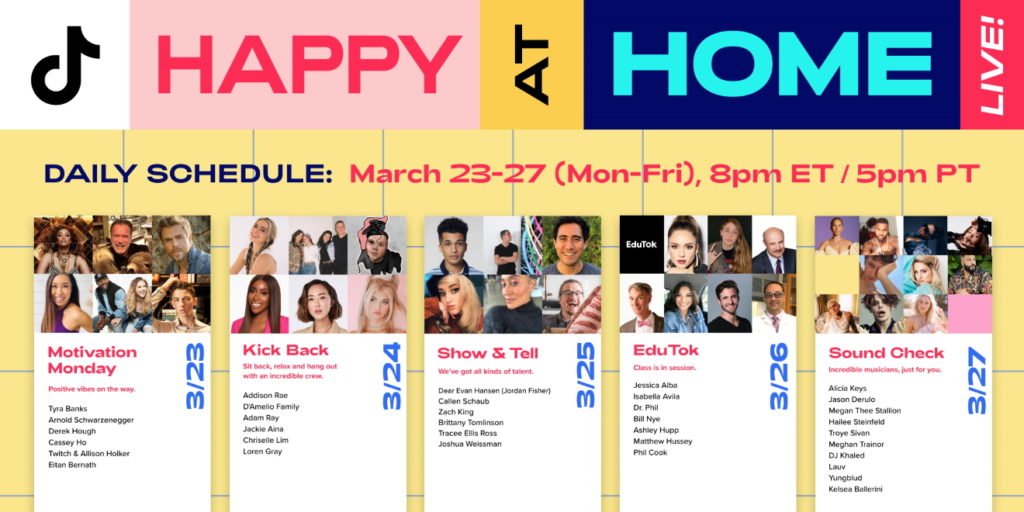
What is it? Social platform enlisting high profile influencers to create content for people at home
Critical Need Served: Entertainment, motivation, education – at a time when we most need it
Why It Works: Young people are already using TikTok – this harnesses the platform to send a positive message
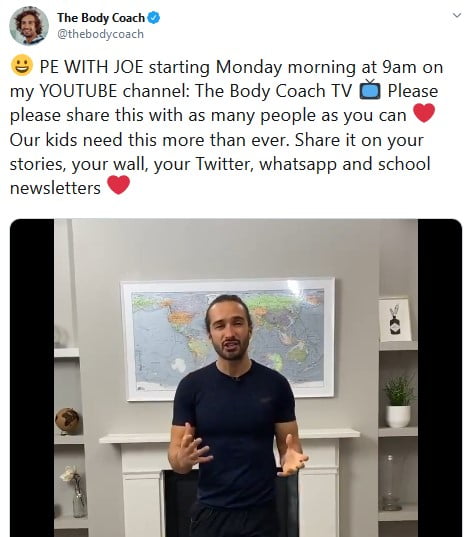
What is it? The Body Coach – a fitness influencer – is running free YouTube PE classes now schools close
Critical Need Served: Keeping kids healthy during school lockdown – and giving parents a break from homeschooling
Why It Works: Joe is using his skillset and fame altruistically – and parents are grateful. He’s been trending in the UK for 2 days since launch
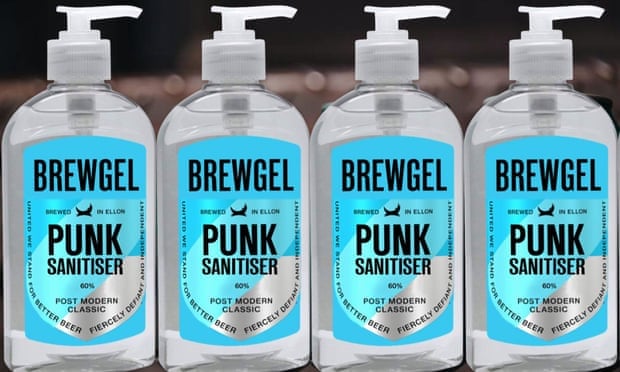
What is it? The Scottish brewery has taken up production of hand sanitiser using beer-making facilities
Critical Need Served: Hand sanitiser is in huge demand as panic buying has depleted supplies – Brewdog is helping get supplies to who needs it
Why It Works: Brewdog is not selling the product but rather giving it away to those who need it most – charity, using the resources they have
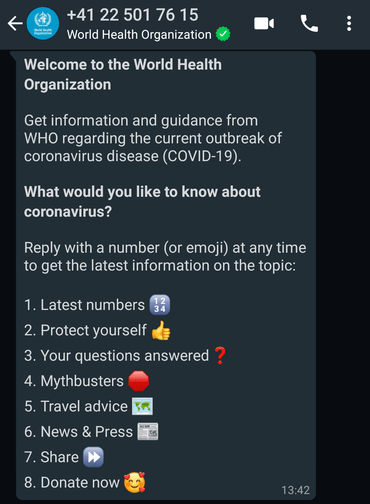
What is it? The World Health Organisation has launched a chatbot to educate people about COVID-19
Critical Need Served: Fake news is rife at times of crisis and people need the right info to make the right choices
Why It Works: WhatsApp has 1.5B active users in 180 countries – huge reach for an info campaign

What is it? CBRE are actively seeking vacant properties which could house NHS workers
Critical Need Served: Many frontline health workers cannot risk families by living at home while exposed
Why It Works: Using access to property owners and developers to offer a service which could save lives
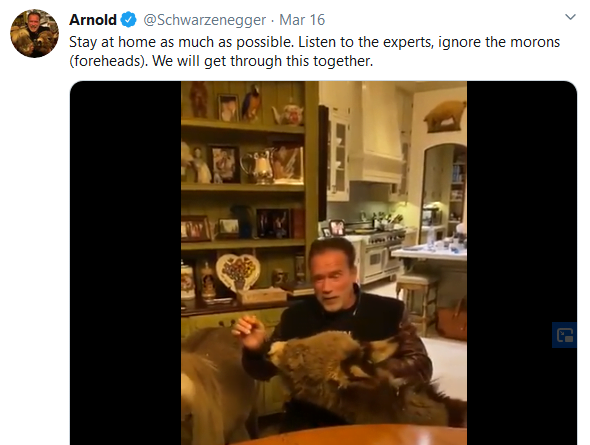
What is it? Arnie asks people to stay safe, stay home
Critical Need Served: Voice of positivity and calm in face of panic, ignoring advice
Why It Works: Well known celebrity and cute animals – a recipe for success
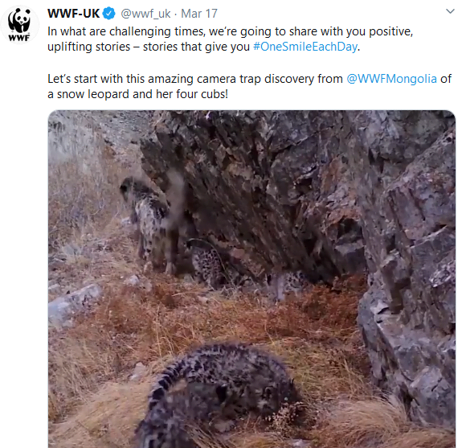
What is it? #OneSmileEachDay hashtag to share positive news
Critical Need Served: Good news in the face of deluge of negativity
Why It Works: Lifting spirits with positive stories from nature
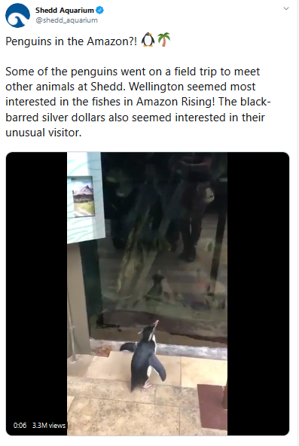
What is it? Aquarium shares penguins exploring
Critical Need Served: Light-hearted entertainment during crisis
Why It Works: Silver lining of mass closures

What is it?A hospital sent Tom Hanks a Wilson as company
Critical Need Served: A smile during a dark time
Why It Works: Humour in face of adversity, positive diagnosis
Sorry – this one was FAKE NEWS (which is rife during times of crisis)
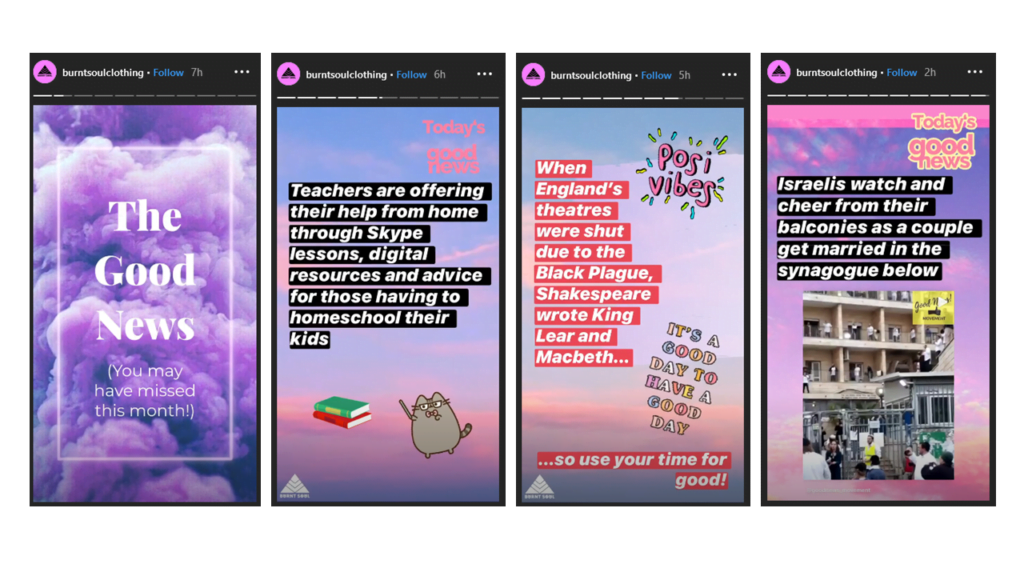
What is it? Good news Instagram Stories
Critical Need Served: Reminder there is still good news out there
Why It Works: Simple, quick, accessible
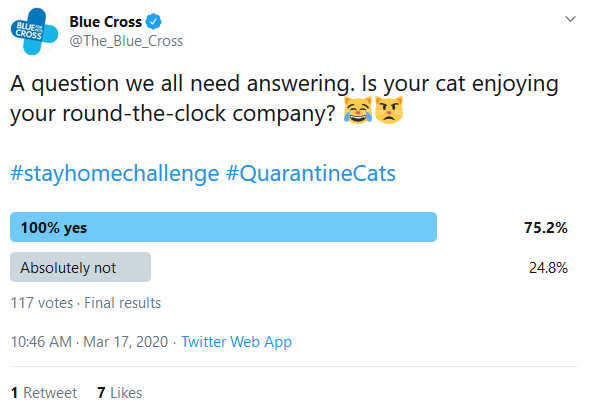
What is it? Twitter poll asking about cats enjoying new work habits
Critical Need Served: Twitter poll asking about cats enjoying new work habits
Why It Works: Light-hearted without being insensitive
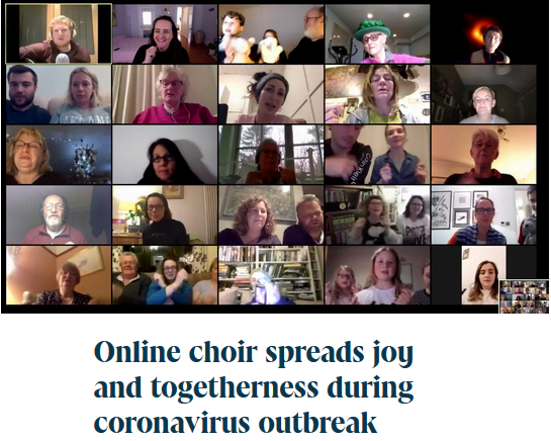
What is it? Online video choir launched
Critical Need Served: Tackling loneliness and boredom
Why It Works: Accessible for most with a laptop or phone
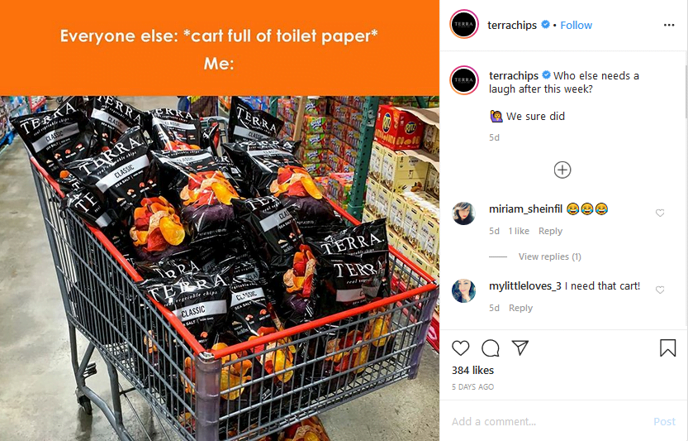
What is it? Gentle joke about stockpiling loo roll
Critical Need Served: Humour in dark times, poking fun at current madness
Why It Works: Gentle humour – not punching down or victimising any party
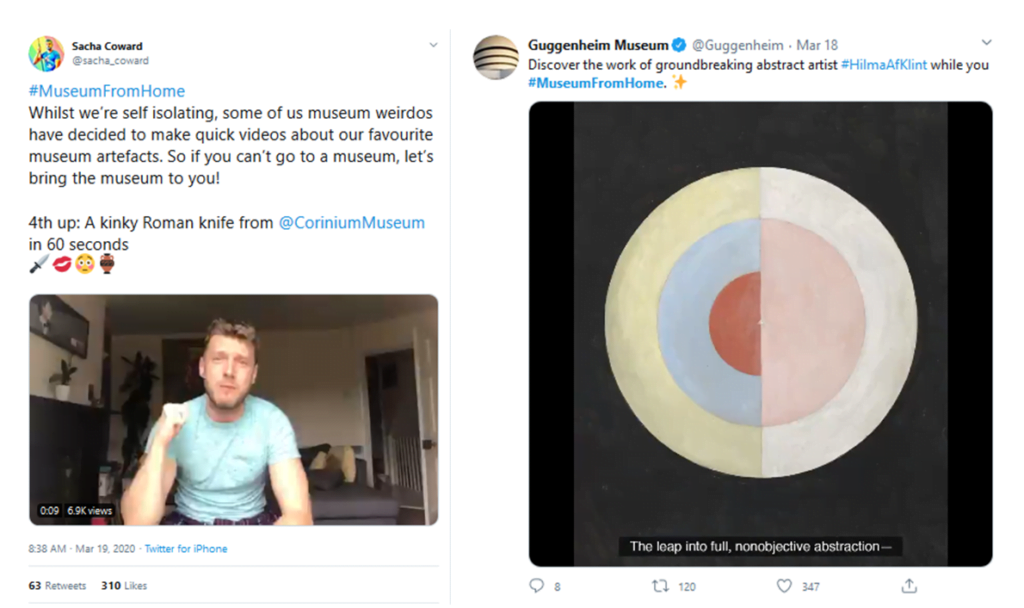
What is it? Bringing museum pieces to the public via Twitter
Critical Need Served: Relieving boredom, giving access to venues which are closed
Why It Works: Generosity of experts sharing their knowledge, easy to consume
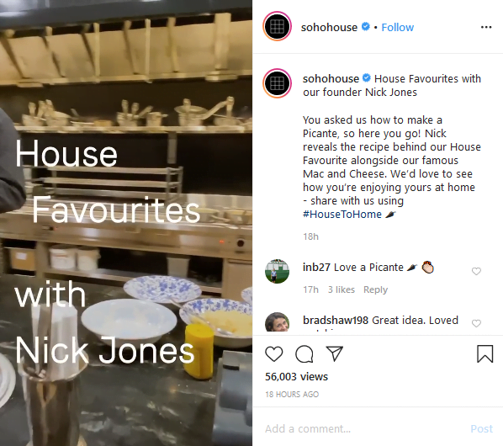
What is it? Cocktail recipe videos from founder of Soho House
Critical Need Served: Access to a much loved signature cocktail while in lock down
Why It Works: Ability to continue enjoying life despite quarantine
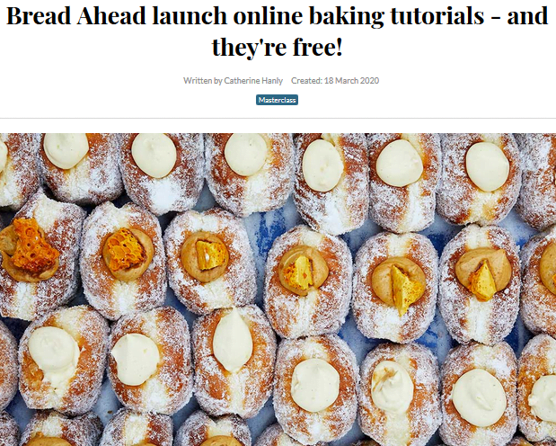
What is it? Online baking tutorials featuring favourite products
Critical Need Served: Put free time to use by learning a new skill
Why It Works: Accessible and educational for quarantined people
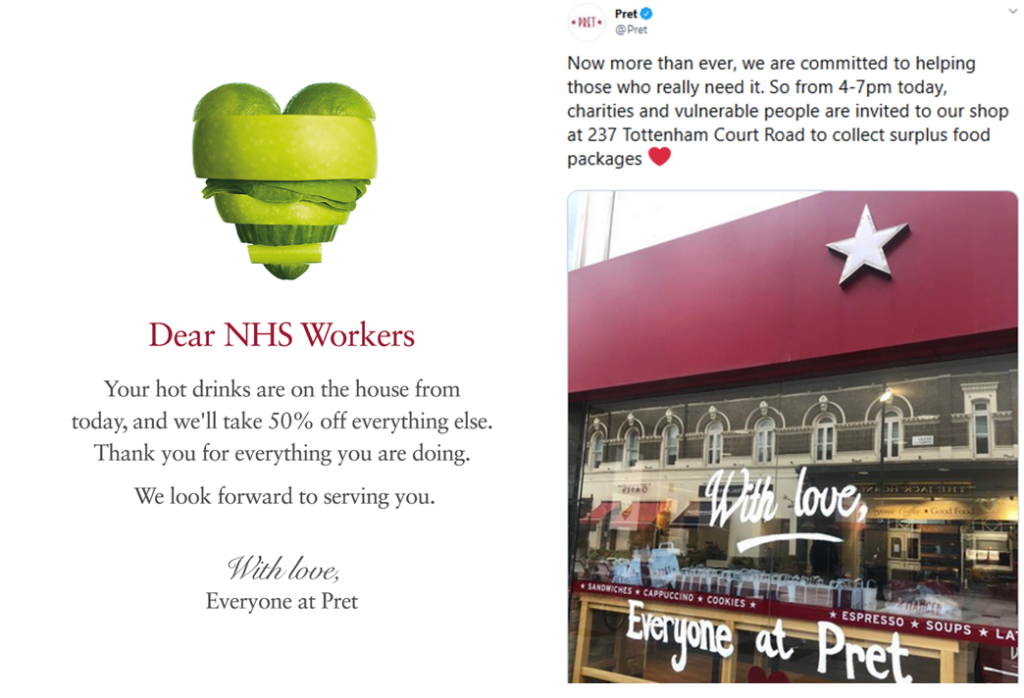
What is it? Pret helping in real terms by offering products for key workers, vulnerable
Critical Need Served: Food for those who urgently need comfort, support and care
Why It Works: Direct help for vulnerable people and front line workers
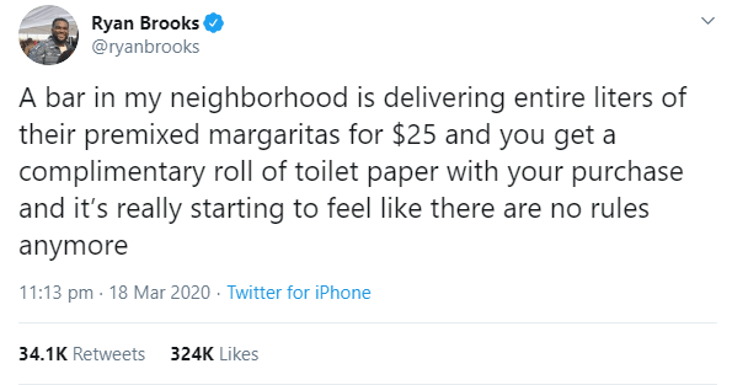
What is it? Bars pivoting their offerings to tailor to self-isolating customers
Critical Need Served: Ability to enjoy normal life from home – and access to scarce loo roll
Why It Works: Ability to support local business is a priority for many at the moment
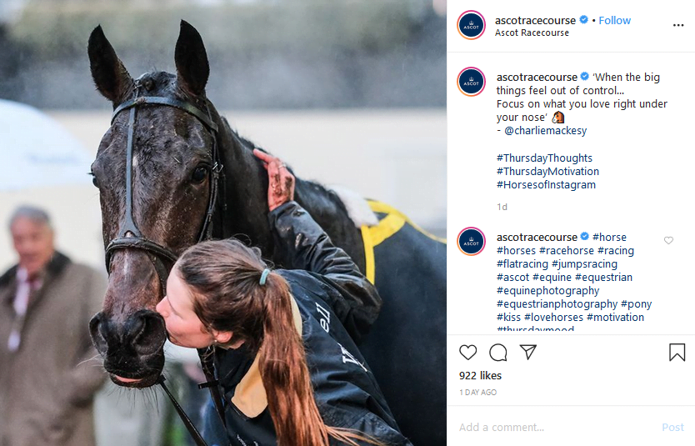
What is it? While racing suspended Ascot has switched social media to positive news
Critical Need Served: Uplifting messages at a difficult time
Why It Works: Positivity in the news feed is welcome at times of crisis
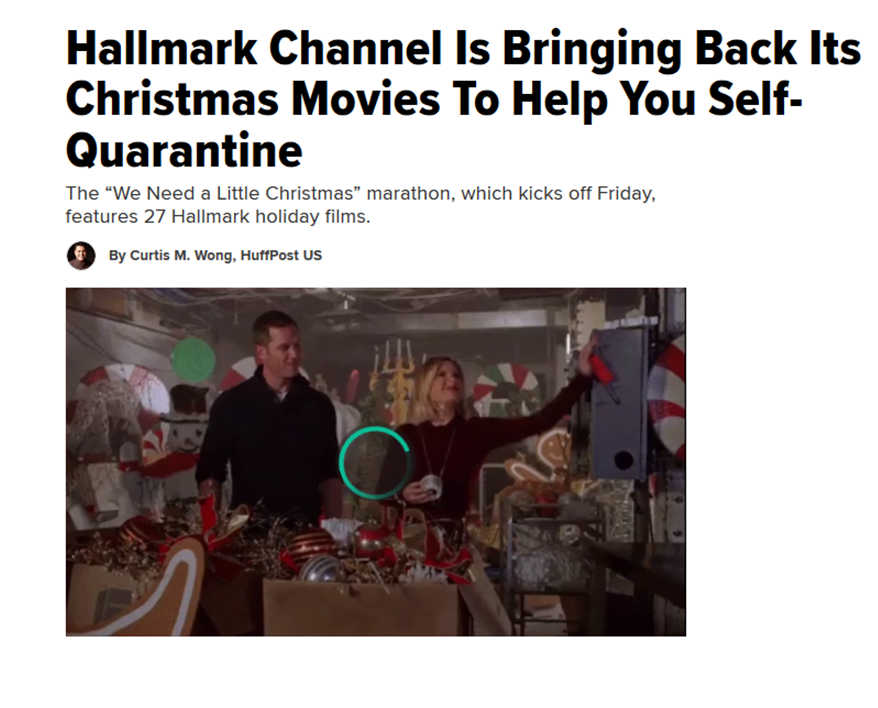
What is it? Cult Christmas movies being made accessible out of season
Critical Need Served: Escapist movies bring joy to many in difficult times
Why It Works: Recognition this is extraordinary time for dedicated fan-base
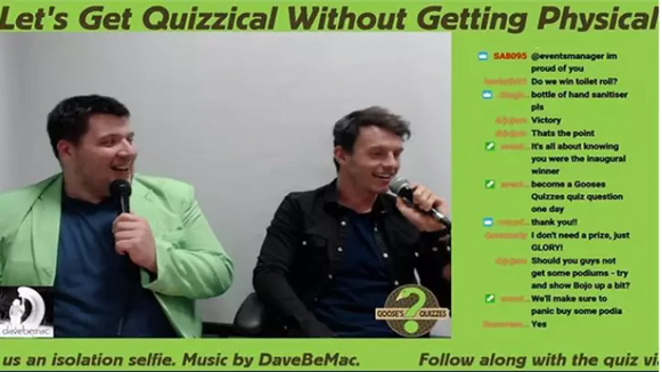
What is it? Pub quizzes move to live video streaming
Critical Need Served: Entertainment and normality during self-isolation
Why It Works: Continued employment for quizmasters and entertainment for quizzers
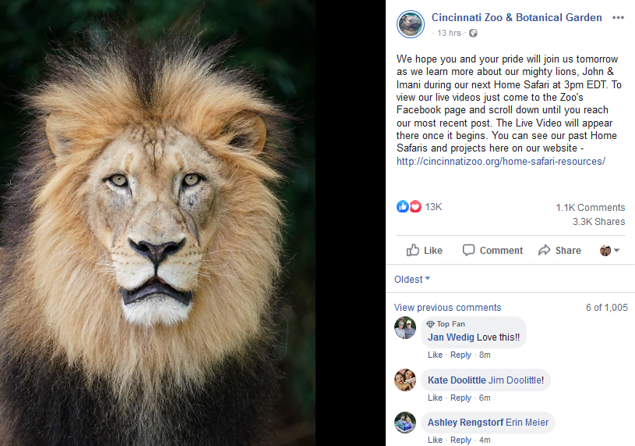
What is it? Live-streaming educational content for kids on Facebook
Critical Need Served: Access to the zoo and educational materials – plus a break for parents
Why It Works: Accessible, fun, educational, gives access to a closed facility
In the digital marketing world, people know the difference between Paid Social and Organic Social. But outside of this world, people might not be able to tell what truly sets them apart. So that’s why I’m going to tell you right now.
In short, Organic Social, as the name suggests, is when an individual or brand posts on their social media account organically to highlight personality and values. Paid Social, on the other hand, allows you to pay money to reach out to new customers and audiences, still promoting brand awareness but not over-exposing it. But let’s dive a little deeper.
What is organic social?
Organic Social advertising showcases your favourite brands and how they can be relatable. Everyone has probably seen a post from their favourite brand where they have thought ‘yeah I can relate to that’ or ‘oh I love that concept’. This is what organic social is all about, bringing people together to form a community and a following. Organic social focuses on bringing people along for an experience and gaining number one fans.
Not only this but with the variety of social media platforms and options that we have available to us, brands are able to tell a story and really connect with their followers. Which is why organic social is so important for brands in this era, in order to build brand awareness you want to attract loyal followers.

What is paid social?
Paid Social differs from organic social in the sense that there is money behind a post to allow brands to promote it. So, when you see a post on your social media feed that has ‘promoted’ underneath it, this is the work of paid social. The social media platforms that allow promoted posts are pretty much the same as organic social, with the use of Facebook, Instagram, Twitter and LinkedIn being the main four.
You can either boost a post that has already been posted on the platform organically to push for further reach, or you can design your own ads to connect to specific audiences, by choosing a campaign objective that best fits your KPI. This style of marketing can not only boost brand awareness but also boost sales for a brand. For example, if a brand had a specific product they wanted to push for more sales, they can look to paid social. By boosting a post or creating a whole new campaign, they can reach a bigger audience and generate those extra sales they need.
Organic and paid social can work together
But why should you consider both strategies for your brand? Even though Paid and Organic Social have their differences, they work together hand in hand. Organic social maintains your follower base and highlights your brand’s message, while paid social takes your brand beyond organic reach and attracts new customers and followers. Of course, you can use either marketing strategy individually but, when paired together they form a strong and effective team!
When you think about campaign strategy for your brand, even if you have a huge worldwide following, it is always a good idea to consider paid social to target further groups or communities. Which will, in turn, expand your following and get your message across to even more people.
No matter how you decide to design your advertising strategy, it’s important to always make sure that you are consistent with your organic campaigns to make sure you maintain a good customer relationship. When you have this, you can add paid social into the mix to reach out to even more potential customers.
Tug’s Social & Content team brought home an award last night at the Digiday Marketing and Advertising Awards Europe!
We’re proud winners of the Best Social Good Campaign 2019, for our amazing work for WWF’s #StopPlasticPollution campaign which ran February – March 2019.
The campaign
WWF created a petition urging world leaders to create a legally binding global agreement to stop plastic leakage into our oceans by 2030. The four-week campaign was set to culminate at the UNEA in Nairobi, when the petition would be presented to the leaders convening there. WWF needed to gather as many signatures as possible to give the petition weight on the global stage.
WWF tasked Tug with creating a social strategy to galvanise people across the world to sign the petition. The strategy was shared with over 100 national offices to ensure a unified message across WWF’s network throughout the campaign.
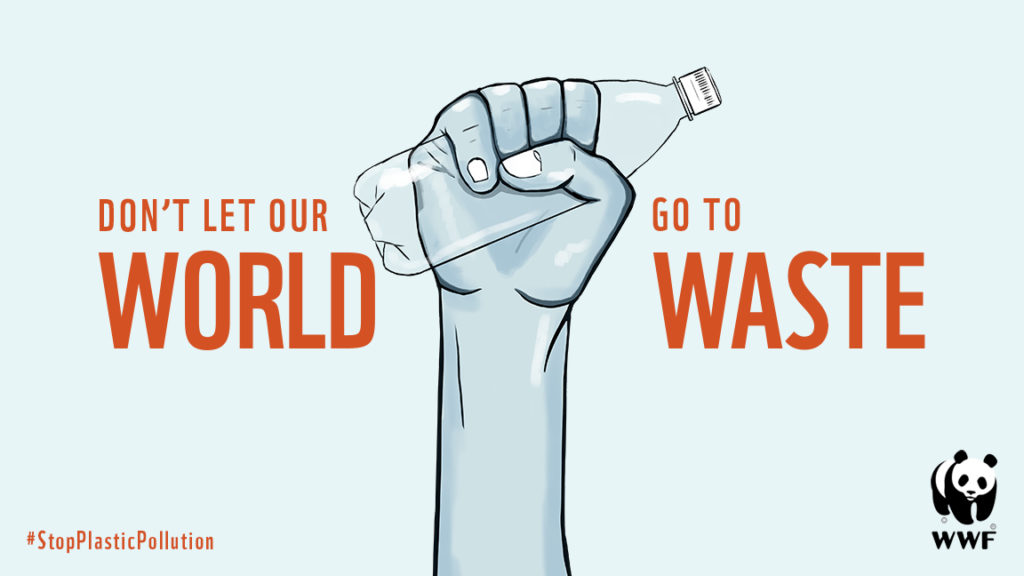
The strategy
We took WWF’s audience on a journey from feeling emotional about the plastic pollution problem, to understanding the problem, to feeling empowered to take action to fix the problem.
The campaign came at a time when people are feeling overwhelmed by negative stories about climate change and the environment. Every day there are new stories about climate degradation, species loss, pollution and other environmental issues. Our A and B audiences of carers and somewhat carers are aware of these issues and feel responsible but helpless to bring about change.
It was imperative that the campaign avoided pointing the blame at individuals and kept the pressure on governments and global leaders who have the power to make positive changes.
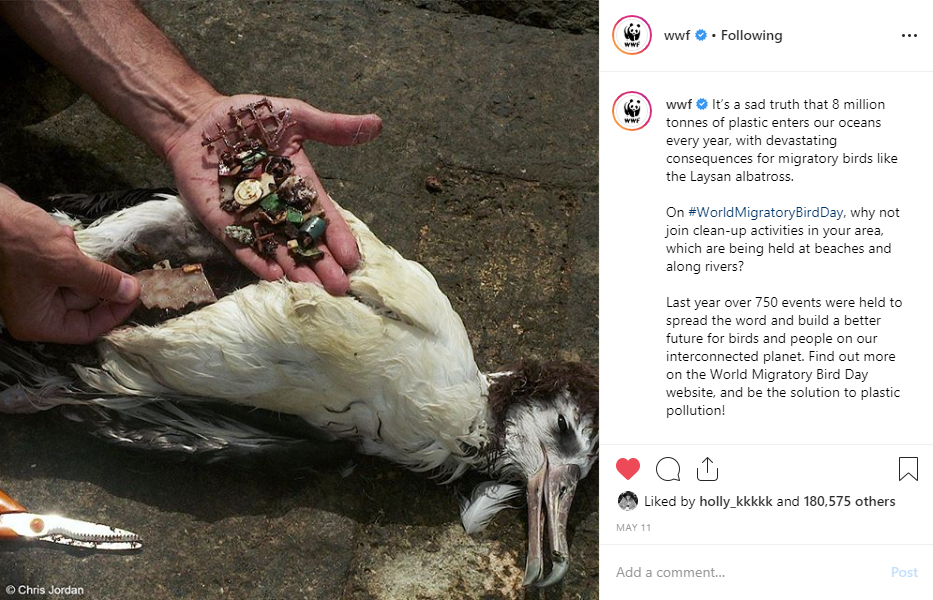
Results
We achieved a total of 44,199 petition clicks from 48 posts on the Stop Plastic Pollution campaign, which is an average of 920 petition clicks per post.
Posts had an impressive 7% engagement rate on Instagram, which is 4% higher than the average 3% engagement rate. In total, the campaign gained 9,191,321 impressions.
We saw a lot of positive sentiment in people’s comments and responses to posts across our channels. The campaign hashtag #StopPlasticPollution now has 80,280 posts on Instagram, which shows that people have been galvanised to continue to campaign for world leaders to take action on plastic pollution.
Due to the success of the Stop Plastic Pollution campaign, WWF made the decision to continue campaigning for signatures after the Nairobi conference and beyond. The petition is still live on their website, currently standing at 1,569,705 signatures.
Tug is currently working on a continuation of the campaign focusing on the holiday season.
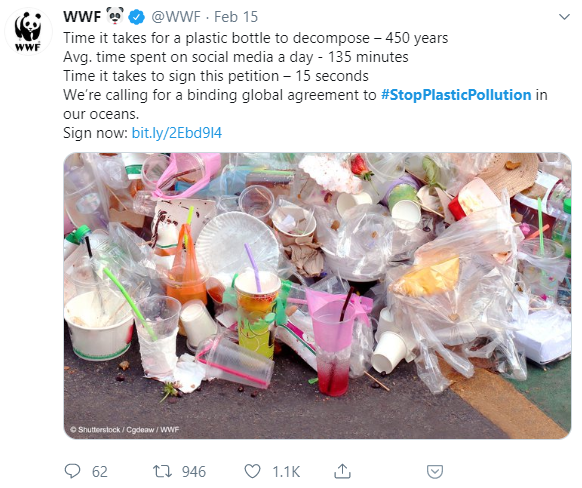
Meeting the wider objectives of the campaign
The Stop Plastic Pollution campaign came at a key moment in time, when public concern about plastic pollution was rising, and some nations like Norway were leading the way in passing legislation to curb plastic pollution. Since the campaign launch, 186 countries have agreed to a UN agreement to monitor and track movements of plastic waste outside their borders.
WWF have continued their messaging around plastic pollution with a further campaign – the Plastic Diet and continue to post updates and relevant news stories across their channels, linking to the petition whenever possible. By continuing to campaign for a global agreement to stop plastic pollution, WWF have positioned themselves as a thought leader on this issue.
We have tied in the messaging around plastic pollution to additional campaigns, such as World Migratory Bird Day. To date, an image of a dead albatross with dozens of plastic fragments in its stomach is the best performing post on Instagram for WWF ever.
The battle for no.10 is officially on. It is all kicking off as Boris prepares to take on Jeremy Corbyn for the Prime Minister title race. Corbyn is refusing to state his position on Brexit (we would all rather trim our Nanna’s toenails than discuss Brexit again,) and Boris can’t seem to string a sentence together. How oh how did we get into this mess?
How Social Media Channels Can Impact Politics
Alongside this question, I am also wondering which social platform will triumph as the most politically impartial, disinformation spreading source of news in the run-up to the 2019 general election.
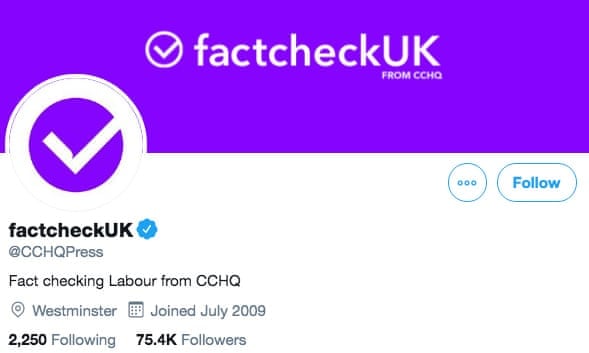
Last month, Twitter’s CEO Jack Dorsey announced it would withdraw from political advertising to stop the spread of misinformation through micro-targeted political advertising on Twitter. Was this a brave and honourable decision or a genius PR stunt?
Considering political ads generate only 0.46% of Twitter’s total revenue (3 million dollars, compared to total 650-million-dollar revenue), the loss doesn’t seem to be too concerning for Twitter. The move has put pressure on Facebook who argues that by stopping political advertising they would be stifling political speech.
How Can Social Channels Prevent the Spread of Misinformation?
It is a difficult line to tread – on the one hand banning all political advertising disassociates your platform from any allegations of fake news or the type of foreign interference we saw in the 2016 US presidential elections. But banning political ads on social channels also risks isolating audiences who rely on social media channels for educational information from politics.
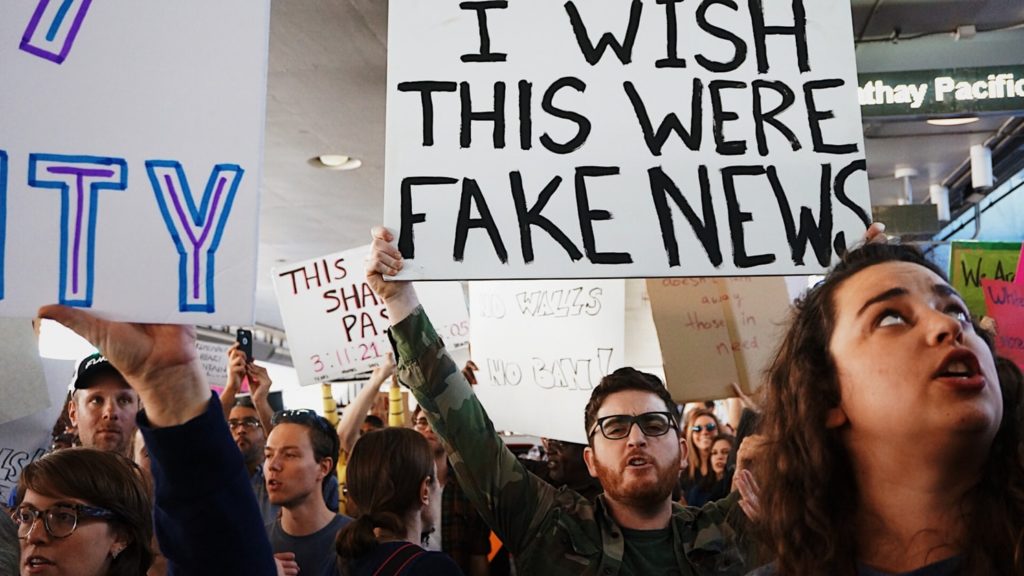
To positively impact political elections, Facebook must consistently and vigorously fact-check political content on their platform. Considering the recent scrutiny Facebook has come under for failing to do so, it was a surprise when they announced that politicians would be exempt from Facebook’s fact-checking scheme.
This is most likely why Facebook was recently forced to remove an ad which falsely claimed that U.S. Republican Senator Lindsey Graham supported the Green New Deal. Politicians are also allowed to post content which breaks Facebook’s rules on hate speech if the content does not cause risk of harm. Hmm… slightly concerning.
Step Aside Social, SEO is here to misinform us all!
Facebook isn’t solely to blame for the spread of misinformation (step aside Facebook, there’s a new political deceiver in town.) Last week it emerged that the Conservative party had paid Google to promote a fake labour manifesto website to the top of the search results on the Google homepage.
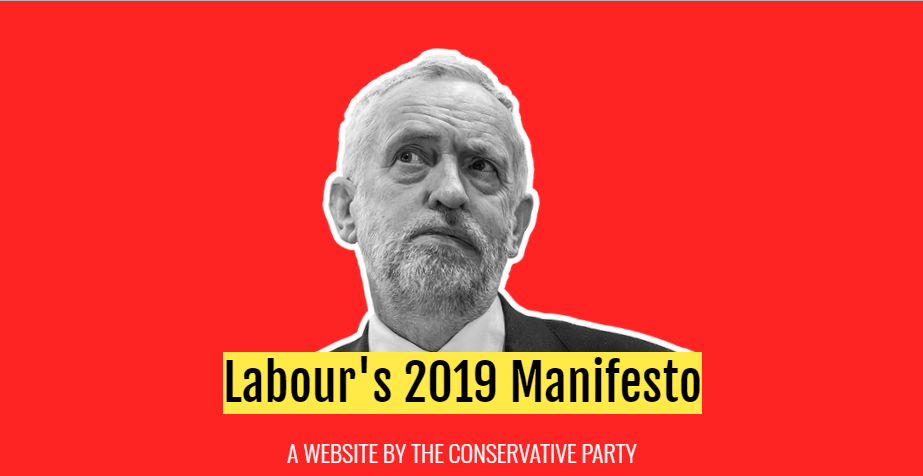
The tactic was used by the Tories to target those searching for the Labour Manifesto online with pro-conservative information instead. The Conservative party has rightly come under a considerable amount of scrutiny for the deceptive move, but Google seems to have come out of the scandal virtually unscathed. Is it one rule for Facebook and another for Google? It seems so.
Policing political news on highly saturated social media channels presents a major challenge, however, one which must be taken seriously. Social media has become a battlefield for fake news and misinformation. This doesn’t mean withdrawing from all political advertising and news from social platforms is the answer. Updating social channel algorithms to restrict the reach of political parties’ pages if they are found to be spreading disinformation could be the deterrent needed to curb this behaviour.
The prospect of the ‘real world’ and getting a ‘real job’ and being told about becoming a ‘real adult’ was something that I was always told about growing up in education, but was never something I thought I would have to actually act upon. Funnily enough I was wrong. Soon came the looming fear of my three-year degree ending and having to come up with a countless amount of make-shift replies to the dreaded question we all hate “So, what are your plans after Uni?”
With two weeks left of university, I spotted a post advertising the need for a Junior Graphic Designer at Tug Agency. I applied on a bus and had no expectations that It would go any further. Six weeks later and one month into my new role as a Junior Graphic Designer at Tug Agency, I now have a good response to the dreaded question we all hate, and an insight into the advertising industry. So, with my new-found experience, I proceed to delve into the hard-hitting facts of – what did university fail to mention and teach me about along the way?
The true meaning of a “fast-paced” agency
The first thing that university never papered me for was the pace of the real world. At university, the shortest project I can remember doing was four weeks long. It roughly went – one week of research, two weeks of experimentation and development and then one week of finalising and making.
As you can imagine, my first week on the job in an agency was definitely a wakeup call, to say the least.
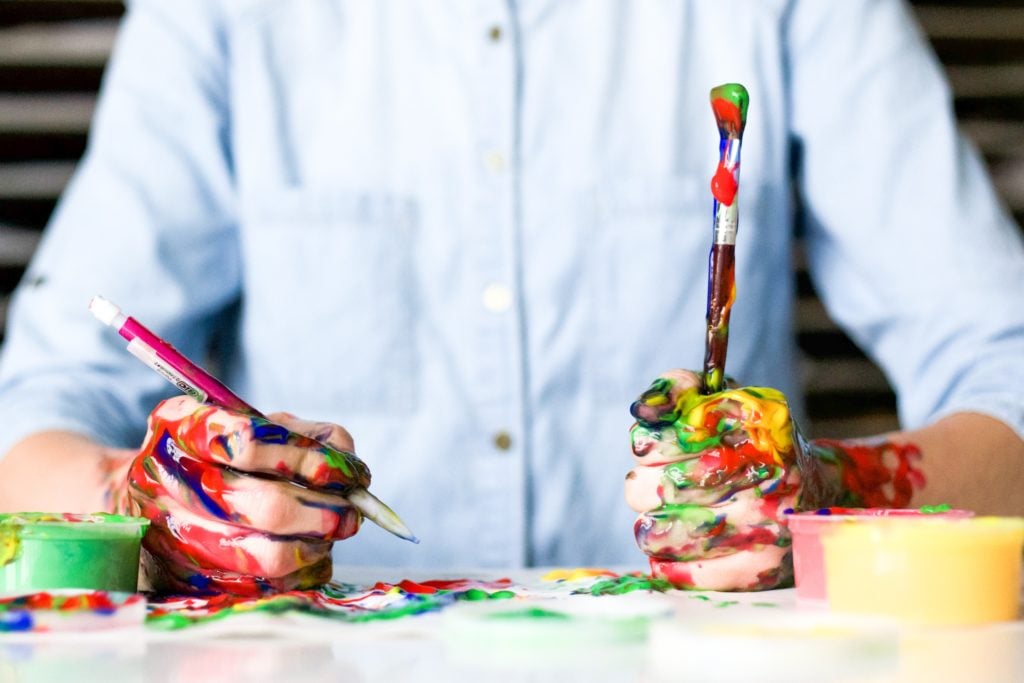
It turns out that in an agency you aren’t finding yourself doing a week’s worth of research but maybe an hour or so before you make the needed creative, finish it off, send the files over for approval and start the next task on your list. What university needed to tell me was I should invest in a good pair of trainers, because you really hit the ground running in an agency.
Don’t think too hard about it
Many times, at university I would hear similar phrases thrown around the studio along the lines of ‘Think outside of the box’ and ‘Think conceptually’ not to mention ‘boring and simple won’t cut it’. Don’t get me wrong, I understand the purpose of an art university; it is a place to develop and push creative boundaries, however when you’re always used to being told to push and push, it’s even harder to restrain and pull back on the abstract ideas to more simple and literal design choices.
In an agency your work will be shared among the general public, who are busy and sometimes need obvious information and visuals straight away. Conceptual ideas aren’t the be-all and end-all of advertising. what University didn’t teach me was the different range of client expectations in design.
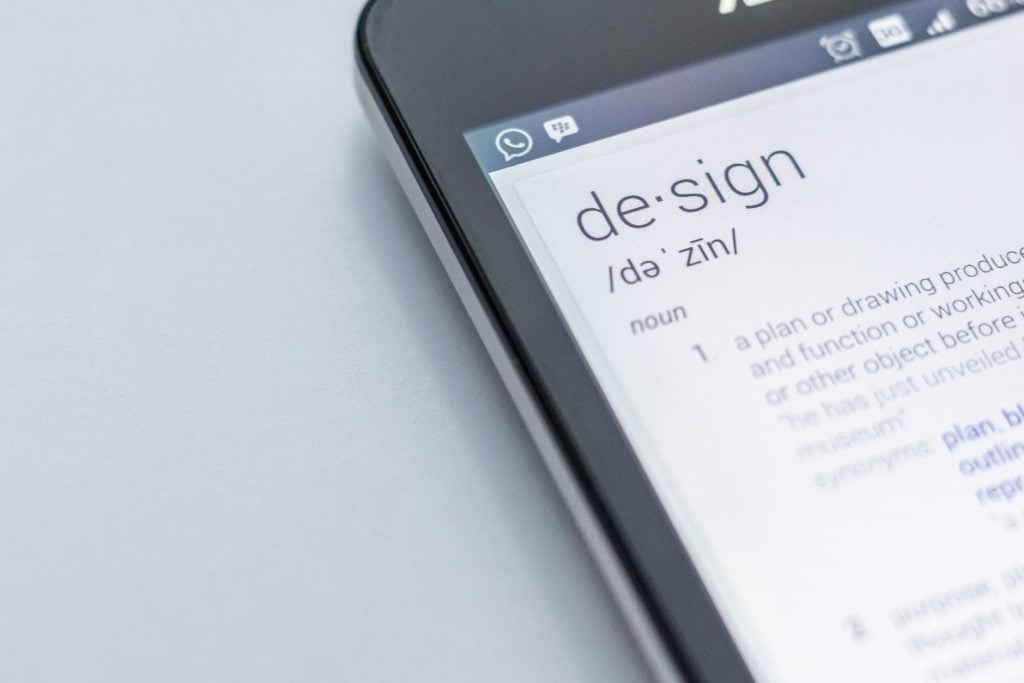
If you want to learn, teach yourself
For my BA degree, I attended a Communication College. I studied there for three years, doing briefs, creating work etc. With a graphic design degree though, there’s a certain element of nostalgia to it. Educators are afraid to let go of traditional methods of work.
My design degree didn’t teach us how to use digital software (kind of ironic how I ended up in a digital marketing agency). My university was the old printing college, meaning traditional techniques such as screen printing, Lithography, Letterpress, were encouraged rather than photoshop, adobe illustrator and Cinema 4D.
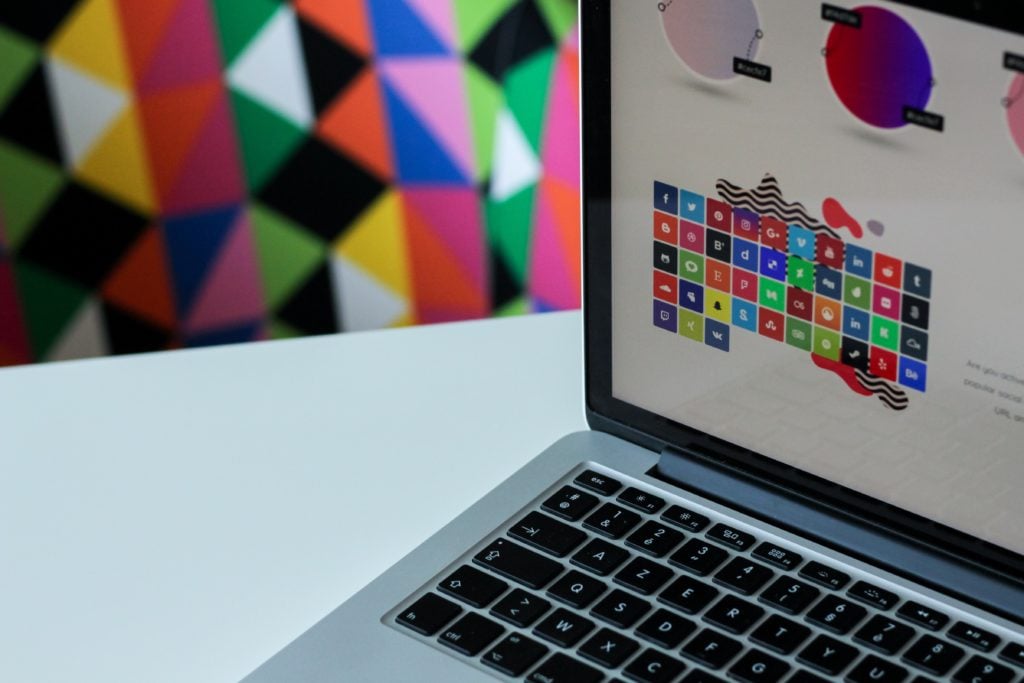
In the second week of being here at Tug, I was given a brief that required me to do a lot with after effects. Having never used it before, I watched a few tutorials and learned as I went along. With the expansion of digital design becoming more common, Universities need to promote and educate students of the suitable software available, as it’s only going to get more and more popular with advertising. And I’m sure in months to come I’ll be learning how to use other software on the job.
A design degree alone won’t cut it
When going through the interview stages at Tug Agency, I realised that they didn’t actually want to talk in detail about my in-depth knowledge of using digital grids and my strong love for san serif fonts, or even my passion for monochromatic colour schemes, but more about what I’ve done in my spare time and what I did outside of university.
Comments from tutors such as ‘getting a First will get you the best job’, ‘the creative industry is very competitive they only take the best.’ Yes, and they are right in some respects, however there was scarily ever any mention of how to make yourself stand out in the creative industry. Having a strong portfolio is one thing, and being an interesting person is another. The tutors at university didn’t ever push for extracurricular activities, it was something I did on my own accord. And when I was having my interview 50% of the time was talking about my work, yet the other 50% was talking about who I was as a person.

The “real world” is pretty great, actually
From my first nervous day, to my 4th week working at tug, I’ve experienced the fast-pace environment of the of advertising world, the unrealistic deadlines from clients and the need constantly learn and keep up to date with industry standard software, university forgot to mention one small thing – I’d enjoy it more!
F8 may be done and dusted, but the announcements made during the conference may mean some big changes to marketers moving forward.
‘Today we’re going to build a privacy-focused social platform.’ These were Zuckerberg’s first words to address the conference. Facebook wants everyone to know that they are serious about privacy and transparency.
With this being the Core focus, the announcements made in F8 are focussed on scaling back on what we are currently seeing to building meaningful relationships online for both users and businesses.

Key announcements at F8
The Facebook feed will look a lot like the mobile app
Zuckerberg announced a new redesign of the desktop feed. Not only will this look similar to the current mobile app (think bigger buttons, quick access functions), but will provide insight on how Facebook will function in the future.
Groups, groups, groups
It’s about to be all about communities and groups. “Putting groups first,” is all about focussing on meaningful relationships and engaging with other users. In the upcoming months, the Groups tab will be redesigned to make discovery easier. Not to mention making it easier for users to participate in these groups, with more group announcements and posts appearing in your newsfeed.
Let’s talk about messenger; lighter, faster and connection
It’s all about connection and communication. Facebook will launch a simplified messenger app, which will have changes to current messenger centric marketing tactics. With new personalised conversions, a business will be able to create a brand person bigger than before, to connect with users.
Conversion focussed possibilities have moved from in-feed placements and now to messenger. With ‘plug-and-play solutions,’ messenger will help push in-store traffic, generate leads and focus on customer care.
Shopping made easy with Instagram
Instagram will start rolling out in-app shopping. This means buying an item without leaving the page. This will make conversion easier for business, streamlining the user experience.
